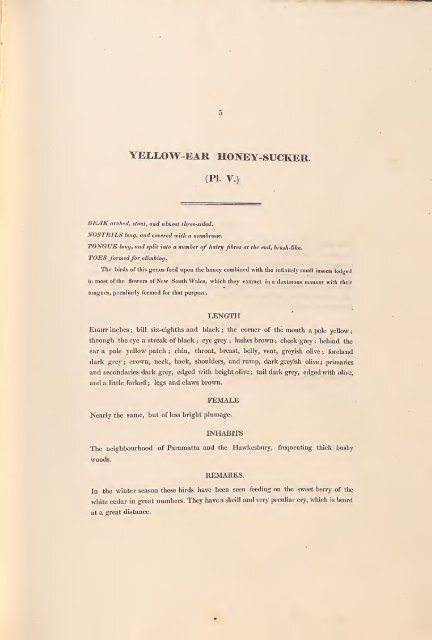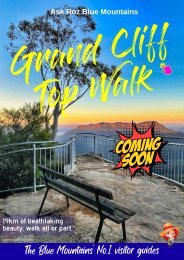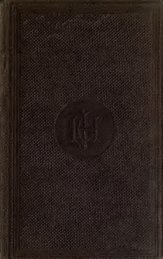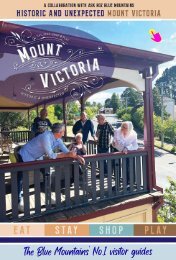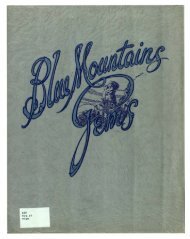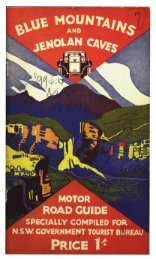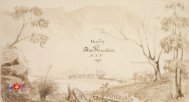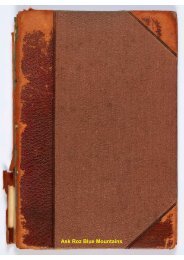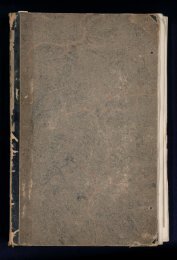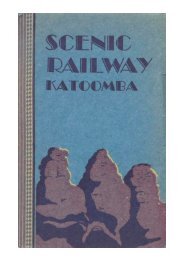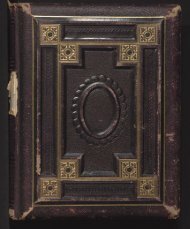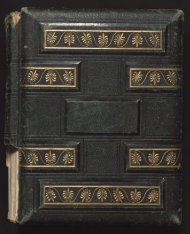A History of the Birds of NSW by John William Lewin
A History of the Birds of NSW by John William Lewin COLLECTED, ENGRAVED, AND FAITHFULLY PAINTED AFTER NATURE
A History of the Birds of NSW by John William Lewin
COLLECTED, ENGRAVED, AND FAITHFULLY PAINTED AFTER NATURE
You also want an ePaper? Increase the reach of your titles
YUMPU automatically turns print PDFs into web optimized ePapers that Google loves.
5<br />
YELLOW-EAR HONEY-SUCKER.<br />
(PI. V.)<br />
BEAK arched, stout, and almost tliree-sided.<br />
NOSTRILS long, and covered with a membrane.<br />
TONGUE long, and split into a number <strong>of</strong> hairy fibres at <strong>the</strong> end, brush-like.<br />
TOES formed for climbing.<br />
The birds <strong>of</strong> this genus feed upon <strong>the</strong> honey combined with <strong>the</strong> infinitely small insects lodged<br />
in most <strong>of</strong> <strong>the</strong> flowers <strong>of</strong> New South Wales, which <strong>the</strong>y extract in a dexterous manner with <strong>the</strong>ir<br />
tongues, peculiarly formed for that purpose.<br />
LENGTH<br />
Eight inches; bill six-eighths and black ; <strong>the</strong> corner <strong>of</strong> <strong>the</strong> mouth a pale yellow;<br />
through <strong>the</strong> eye a streak <strong>of</strong> black ; eye grey ; lashes brown ; cheek grey : behind <strong>the</strong><br />
ear a pale yellow patch ; chin, throat, breast, belly, vent, greyish olive; forehead<br />
dark grey; crown, neck, back, shoulders, and rump, dark greyish olive; primaries<br />
and secondaries dark grey, edged with bright olive; tail dark grey, edged with olive,<br />
and a little forked ; legs and claws brown.<br />
FEMALE<br />
Nearly <strong>the</strong> same, but <strong>of</strong> less bright plumage.<br />
INHABITS<br />
The neighbourhood <strong>of</strong> Paramatta and <strong>the</strong> Hawkesbury, frequenting thick bushy<br />
woods.<br />
REMARKS.<br />
In <strong>the</strong> winter season <strong>the</strong>se birds have been seen feeding on <strong>the</strong> sweet berry <strong>of</strong> <strong>the</strong><br />
white cedar in great numbers. They have a shrill and very peculiar cry, which is heard<br />
at a great distance.


